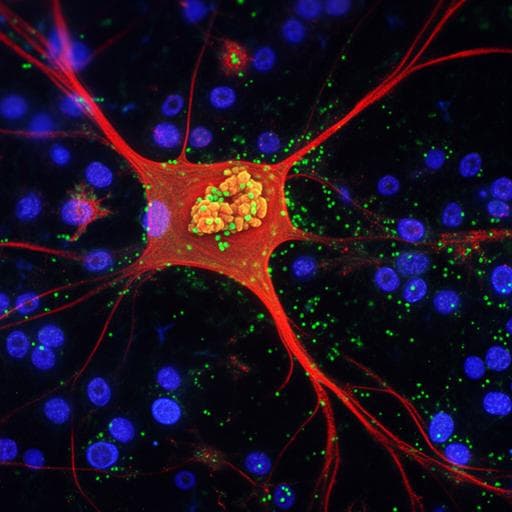
Medicine and Health
Turn-on chemiluminescence probes and dual-amplification of signal for detection of amyloid beta species in vivo
J. Yang, W. Yin, et al.
Discover how researchers Jing Yang, Wei Yin, and colleagues have developed ADLumin-1, an innovative turn-on chemiluminescence probe that effectively targets amyloid beta species. This groundbreaking probe not only crosses the blood-brain barrier but also enhances imaging of Aβ plaques, presenting new possibilities for understanding neurodegenerative diseases.
~3 min • Beginner • English
Introduction
The study addresses the limitations of near-infrared fluorescence (NIRF) imaging that arise from the need for external excitation light, including autofluorescence, limited tissue penetration due to shorter excitation wavelengths, excitation leakage, and depth bias that reduces signal-to-noise ratio. Chemiluminescence imaging, which does not require excitation light, can mitigate these issues and enhance penetration at the same emission wavelengths. However, chemiluminescence has seen limited biological application due to low sensitivity, probe irreversibility, and reliance on reactive oxygen (nitrogen) species. The authors propose a turn-on chemiluminescent probe, ADLumin-1, for detecting Aβ species in Alzheimer’s disease, aiming to achieve high contrast and sensitivity in vitro and in vivo. They further hypothesize that pairing ADLumin-1 (chemiluminescent donor) with CRANAD-3 (a smart NIRF acceptor) can realize dual-amplification via chemiluminescence resonance energy transfer (DAS-CRET), shifting emission into the NIR window and improving tissue penetration and detection sensitivity.
Literature Review
Multiple chemiluminescent scaffolds (dioxetane, luminol, imidazo[1,2-a]pyrazin-3(7H)-one, oxalate, lucigenin, 9,10-dimethyl-anthracene, acridinium) are known but typically emit at <500 nm and have drawbacks for brain imaging (e.g., charged/polar scaffolds limiting BBB penetration, wavelength extension challenges, or stability issues). Imidazo[1,2-a]pyrazin-3(7H)-one (IPO) derivatives offer modifiability and stability. Chemiluminescence has been used in various diseases but infrequently in brain disorders; most probes target ROS. Turn-on fluorescence probes for Aβs (including the CRANAD series developed by the authors) are abundant, whereas smart turn-on chemiluminescent probes for Aβs are rare and had not been applied to Aβ detection. CRET has been used in biology, but donor–acceptor pairs generally lack target-dependent signal amplification. Prior work showed non-conjugated FRET between small molecules bound to Aβ β-sheets due to close proximity, though in vivo application was limited by excitation requirements and cross-excitation. These gaps motivate the development of a smart chemiluminescent Aβ probe and a dual-turn-on non-conjugated CRET strategy to extend emission and amplify signals.
Methodology
Probe design and synthesis: ADLumin-1 (and ADLumin-2) were designed using IPO as the chemiluminescent core (moiety A) linked via conjugated double bonds to a hydrophobic, planar binding motif (moiety B) that targets Aβ β-sheets, enabling electron delocalization for red-shifted emission and turn-on upon binding. Straightforward synthesis was performed (TMP/n-BuLi; Pd-catalyzed coupling; cyclization with methylglyoxal acetal). ADLumin-1 was selected for further work due to higher quantum yield than ADLumin-2.
Spectral/chemical characterization: Fluorescence excitation/emission recorded in DMSO (ADLumin-1 emission ~590 nm). Chemiluminescence assessed in solvents (notably in DMSO with peak ~540 nm) and under oxygen modulation. Oxygen bubbling (5 s cycles) and stirring tested to probe oxygen dependence. LC-MS, 1H/13C NMR, and HR-MS used to identify oxidation product ADLumin-3; a tentative oxygen-addition/decomposition mechanism was proposed.
ROS/O2 sensitivity: Responses to various ROS (H2O2, ClO2, TBHP, KO2) in PBS were compared to O2 bubbling, using IVIS chemiluminescence imaging (open filter 500–840 nm) to quantify intensity changes.
Aβ binding and turn-on assays: Fluorescence turn-on with Aβ40 aggregates measured (Ex 410–420 nm, Em 450–700 nm). Binding affinity Kd estimated by titration (~2.1 μM). Chemiluminescence turn-on quantified in PBS (5% DMSO) with Aβ aggregates. Molecular docking performed with Aβ42 fibrils (PDB 5OQV) to identify binding groove residues.
In vitro plate and tissue assays: 96-well IVIS imaging compared ADLumin-1 with and without Aβ aggregates in PBS; mouse brain homogenates were spiked with/without Aβ (final 12.5 μM) to assess signal differences and linearity vs Aβ concentration.
Tissue penetration test: Glass tubes containing comparable total emitted light from ADLumin-1 or firefly luciferin/luciferase were placed under the abdomen of nude mice (~1.5 cm depth); dorsal-side IVIS imaging quantified penetrated light percentage.
Two-photon and histology: A 5xFAD mouse underwent two-photon cranial window imaging after i.v. ADLumin-1 (4 mg/kg; 15% cremophor, 15% DMSO, 70% PBS). Vessels labeled with Rhodamine B isothiocyanate-Dextran; emission channels 500–550 nm (ADLumin-1) and 570–620 nm (vessels). Time-course imaging captured plaque and CAA signals; post-imaging brain sectioning and ex vivo fluorescence histology confirmed in vivo labeling. Additional ex vivo staining on APP/PS1 brain slices with ADLumin-1 assessed plaque contrast.
In vivo chemiluminescence imaging (ADLumin-1): 5xFAD and age-matched WT mice received i.v. ADLumin-1 (4 mg/kg). IVIS imaging performed with open and specific emission filters (500–840 nm; emphasis at 640 nm). ROI analyses on brain, eyes, and other regions quantified group differences over time.
DAS-CRET development: Non-conjugated CRET pair formed by ADLumin-1 (donor) and CRANAD-3 (acceptor), both turn-on upon Aβ binding. In PBS and mouse brain homogenate, mixtures of ADLumin-1, CRANAD-3, and Aβ aggregates were imaged; spectral overlap and energy transfer assessed at acceptor emission (~640–660 nm). Spectral unmixing (Living Image 4.2.1) separated donor-only, CRET, and acceptor-only contributions.
In vivo DAS-CRET mimic: Subcutaneous injections of ADLumin-1+Aβ (control) vs ADLumin-1+CRANAD-3+Aβ (CRET) into opposite hind limbs of a nude mouse, followed by ventral and dorsal IVIS imaging with open and multi-filter acquisition; spectral unmixing applied.
In vivo brain DAS-CRET: 5xFAD and WT mice received i.v. mixture of ADLumin-1 and CRANAD-3 (both 4 mg/kg; same vehicle). Imaging with open and specific filters (including 640 nm) and spectral unmixing quantified AD/WT margins. Ocular DAS-CRET imaging was also performed.
Statistics: Data reported as mean ± s.d.; Student’s t-tests (two-tailed, unpaired) used for significance testing; n commonly 3 for in vitro replicates and 3–4 animals for in vivo.
Key Findings
- ADLumin-1 exhibits chemiluminescence in DMSO with emission peak ~540 nm and fluorescence emission ~590 nm; stirring increased chemiluminescence 3.4-fold and O2 bubbling produced a 27-fold increase initially, indicating oxygen-dependent auto-oxidation producing ADLumin-3 (confirmed by LC-MS/NMR/HR-MS). P=0.0009 for stirring vs non-stirring.
- ADLumin-1 is a smart turn-on probe for Aβ fibrils: fluorescence increased ~100-fold upon Aβ40 aggregates; Kd ≈ 2.1 μM. Molecular docking suggests binding in a hydrophobic groove (Phe19, Ala21, Val24, Asn27, Ile31), consistent with observed blue-shift in fluorescence.
- Chemiluminescence turn-on with Aβ: ~216-fold increase at 540 nm in PBS (5% DMSO). In 96-well IVIS imaging, wells with Aβ gave 104-fold higher chemiluminescence than without (P=0.0005).
- In mouse brain homogenate, ADLumin-1 chemiluminescence was 11.6-fold higher with Aβ vs without (P<0.0001), and scaled linearly with Aβ concentration up to 12.5 μM.
- Despite shorter peak wavelength, ADLumin-1’s broader FWHM (94 nm) enabled whole-body penetration comparable to firefly luciferin; ~5% of light penetrated a ~1.5 cm path for both.
- Two-photon imaging: ADLumin-1 crossed the BBB rapidly; provided high-contrast labeling of plaques and cerebral amyloid angiopathy (CAA). SNRs: plaques ~17.0, CAA ~26.0 in vivo; ex vivo plaques remained bright. Slice staining SNR ~2.93.
- In vivo chemiluminescence brain imaging (ADLumin-1): 5xFAD mice showed 1.7–1.8-fold higher brain signals than WT at 15–30 min post-injection; 640 nm filter captured maximal brain signals with ~1.7-fold AD/WT difference, indicating brain-originated signals. Eye signals were 1.6-fold higher in 5xFAD; nose signals also higher (~1.7-fold).
- DAS-CRET in PBS: Strong CRET observed only with Aβ present; 133-fold signal increase at ~660 nm due to dual turn-on of donor and acceptor.
- DAS-CRET in brain homogenate: CRET signal at ~640 nm increased 11.4-fold with Aβ; CRET mixture produced 2.38-fold higher signal than donor-only at 640 nm. Spectral unmixing increased CRET vs non-CRET difference up to 31-fold.
- In vivo DAS-CRET mimic (subcutaneous): CRET site exceeded control by 1.34-fold (ventral) and 1.42-fold (dorsal ~1.2 cm path); spectral unmixing improved contrast to 2.72-fold.
- In vivo brain DAS-CRET (i.v.): Open filter AD/WT ratio 2.04; at 640 nm, 2.25-fold higher in 5xFAD; spectral unmixing increased AD/WT margin to 3.22. The CRET pair increased absolute 640 nm signals vs ADLumin-1 alone by 2.10-fold (AD) and 1.66-fold (WT). Ocular DAS-CRET yielded a 2.11-fold AD/WT difference.
- Reported significances: Fig. 2b P=0.0009; Fig. 3e P=0.0005; Fig. 3g P<0.0001; Fig. 5d–f P<0.0001; Fig. 6b P<0.0001; Fig. 6d P=0.0098; Fig. 9c P=0.0059; Fig. 9d P=0.0292; Fig. 9e P=0.0133.
Discussion
The work demonstrates that a rationally designed hydrophobic chemiluminescent probe (ADLumin-1) undergoes substantial turn-on upon binding to Aβ fibrils, likely due to binding within hydrophobic β-sheet grooves that restrict intramolecular rotations and enhance emission. Oxygen-dependent auto-oxidation enables chemiluminescence without added ROS, and the probe’s broad emission width compensates for its shorter peak, supporting in vivo imaging. Importantly, pairing ADLumin-1 with a smart NIRF acceptor (CRANAD-3) realizes a non-conjugated dual-amplification CRET (DAS-CRET), efficiently transferring energy to longer wavelengths, increasing tissue penetration, and substantially enhancing sensitivity. The CRET effect is favored by both probes’ turn-on in hydrophobic β-sheet environments and by their close proximity when co-bound to Aβ aggregates, providing large in vitro and in vivo AD/WT margins, especially after spectral unmixing. These findings address the limitations of excitation-dependent optical imaging and extend chemiluminescence to amyloid detection in brain and eye, suggesting broad utility for other misfolded proteinopathies and potential translational applications (e.g., ocular imaging).
Conclusion
ADLumin-1 is introduced as the first smart chemiluminescent turn-on probe for Aβ species, validated across solution, brain homogenate, and in vivo brain and ocular imaging with meaningful AD/WT contrasts. The study establishes a dual-amplification, non-conjugated CRET strategy (DAS-CRET) using ADLumin-1 and CRANAD-3 to shift emission into the NIR and amplify signals, yielding larger margins and improved sensitivity, especially when combined with spectral unmixing. These contributions provide a complementary optical modality to fluorescence for deep-tissue amyloid imaging. Future directions include extending the design and DAS-CRET approach to other misfolded proteins (tau, α-synuclein, TDP-43, amylin, prion, FUS, SOD, transthyretin), optimizing assays for direct reporting of Aβ in unprocessed tissue homogenates or biofluids, validating nasal/ocular biomarkers in larger cohorts, applying to larger animal models (e.g., marmosets), and further elucidating the chemiluminescence mechanism and pharmacokinetics.
Limitations
- Emission peak of ADLumin-1 is relatively short; although broader FWHM and CRET mitigate penetration limits, donor-alone emission is not NIR.
- Chemiluminescence relies on oxygen-dependent auto-oxidation; detailed mechanism remains tentative and may impose context-dependent variability.
- ADLumin-1 did not show significant chemiluminescence change with Aβ oligomers, indicating preferential detection of fibrillar species rather than all Aβ forms.
- Sample sizes for in vivo comparisons were modest (typically n=3–4), warranting larger studies for robustness and translational validation.
- Differences observed in nose/eye signals require further validation in additional AD models and human studies.
- Non-conjugated CRET efficiency depends on co-localization within β-sheets; heterogeneity of in vivo target distribution could affect reproducibility; spectral unmixing is needed to maximize contrast.
- Full optimization for direct quantification in complex matrices (e.g., homogenates/CSF) is ongoing, and absolute quantitation protocols were not established here.
Related Publications
Explore these studies to deepen your understanding of the subject.







